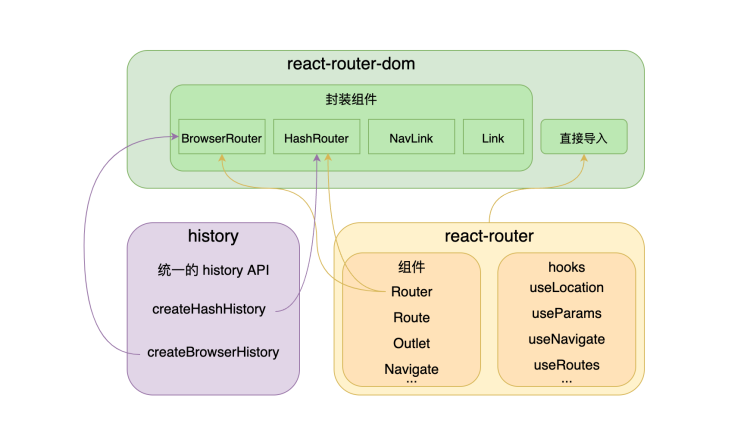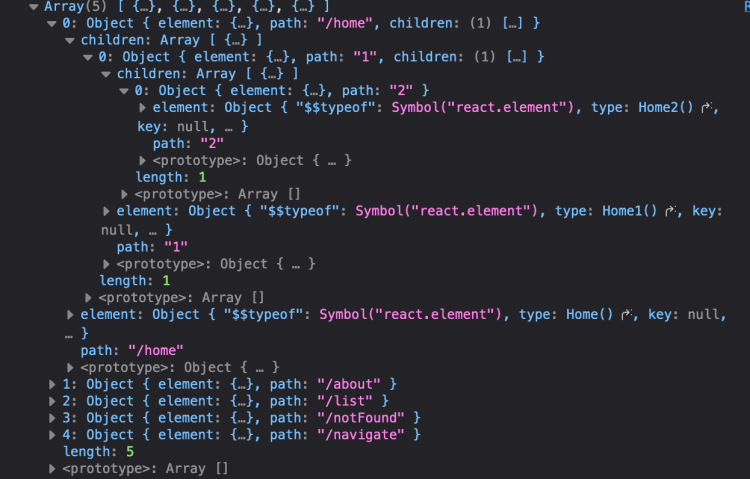- A+
我们是袋鼠云数栈 UED 团队,致力于打造优秀的一站式数据中台产品。我们始终保持工匠精神,探索前端道路,为社区积累并传播经验价值。
本文作者:霜序
前言
在前一篇文章中,我们详细的说了 react-router@3.x 升级到 @6.x 需要注意的问题以及变更的使用方式。
react-router 版本更新非常快,但是它的底层实现原理确是万变不离其中,在本文中会从前端路由出发到 react-router 原理总结与分享。
前端路由
在 Web 前端单页面应用 SPA(Single Page Application)中,路由是描述 URL 和 UI 之间的映射关系,这种映射是单向的,即 URL 的改变会引起 UI 更新,无需刷新页面
如何实现前端路由
实现前端路由,需要解决两个核心问题
- 如何改变 URL 却不引起页面刷新?
- 如何监测 URL 变化?
在前端路由的实现模式有两种模式,hash 和 history 模式,分别回答上述两个问题
hash 模式
- hash 是 url 中 hash(#) 及后面的部分,常用锚点在页面内做导航,改变 url 中的 hash 部分不会引起页面的刷新
- 通过 hashchange 事件监听 URL 的改变。改变 URL 的方式只有以下几种:通过浏览器导航栏的前进后退、通过
<a>标签、通过window.location,这几种方式都会触发hashchange事件
history 模式
- history 提供了
pushState和replaceState两个方法,这两个方法改变 URL 的 path 部分不会引起页面刷新 - 通过 popchange 事件监听 URL 的改变。需要注意只在通过浏览器导航栏的前进后退改变 URL 时会触发
popstate事件,通过<a>标签和pushState/replaceState不会触发popstate方法。但我们可以拦截<a>标签的点击事件和pushState/replaceState的调用来检测 URL 变化,也是可以达到监听 URL 的变化,相对hashchange显得略微复杂
JS 实现前端路由
基于 hash 实现
由于三种改变 hash 的方式都会触发hashchange方法,所以只需要监听hashchange方法。需要在DOMContentLoaded后,处理一下默认的 hash 值
// 页面加载完不会触发 hashchange,这里主动触发一次 hashchange 事件,处理默认hash window.addEventListener('DOMContentLoaded', onLoad); // 监听路由变化 window.addEventListener('hashchange', onHashChange); // 路由变化时,根据路由渲染对应 UI function onHashChange() { switch (location.hash) { case '#/home': routerView.innerHTML = 'This is Home'; return; case '#/about': routerView.innerHTML = 'This is About'; return; case '#/list': routerView.innerHTML = 'This is List'; return; default: routerView.innerHTML = 'Not Found'; return; } } 基于 history 实现
因为 history 模式下,<a>标签和pushState/replaceState不会触发popstate方法,我们需要对<a>的跳转和pushState/replaceState做特殊处理。
- 对
<a>作点击事件,禁用默认行为,调用pushState方法并手动触发popstate的监听事件 - 对
pushState/replaceState可以重写 history 的方法并通过派发事件能够监听对应事件
var _wr = function (type) { var orig = history[type]; return function () { var e = new Event(type); e.arguments = arguments; var rv = orig.apply(this, arguments); window.dispatchEvent(e); return rv; }; }; // 重写pushstate事件 history.pushState = _wr('pushstate'); function onLoad() { routerView = document.querySelector('#routeView'); onPopState(); // 拦截 <a> 标签点击事件默认行为 // 点击时使用 pushState 修改 URL并更新手动 UI,从而实现点击链接更新 URL 和 UI 的效果。 var linkList = document.querySelectorAll('a[href]'); linkList.forEach((el) => el.addEventListener('click', function (e) { e.preventDefault(); history.pushState(null, '', el.getAttribute('href')); onPopState(); }), ); } // 监听pushstate方法 window.addEventListener('pushstate', onPopState()); // 页面加载完不会触发 hashchange,这里主动触发一次 popstate 事件,处理默认pathname window.addEventListener('DOMContentLoaded', onLoad); // 监听路由变化 window.addEventListener('popstate', onPopState); // 路由变化时,根据路由渲染对应 UI function onPopState() { switch (location.pathname) { case '/home': routerView.innerHTML = 'This is Home'; return; case '/about': routerView.innerHTML = 'This is About'; return; case '/list': routerView.innerHTML = 'This is List'; return; default: routerView.innerHTML = 'Not Found'; return; } } React-Router 的架构

- history 库给 browser、hash 两种 history 提供了统一的 API,给到 react-router-dom 使用
- react-router 实现了路由的最核心能力。提供了
<Router>、<Route>等组件,以及配套 hook - react-router-dom 是对 react-router 更上一层封装。把 history 传入
<Router>并初始化成<BrowserRouter>、<HashRouter>,补充了<Link>这样给浏览器直接用的组件。同时把 react-router 直接导出,减少依赖
History 实现
history
在上文中说到,BrowserRouter使用 history 库提供的createBrowserHistory创建的history对象改变路由状态和监听路由变化。
❓ 那么 history 对象需要提供哪些功能讷?
- 监听路由变化的
listen方法以及对应的清理监听unlisten方法 - 改变路由的
push方法
// 创建和管理listeners的方法 export const EventEmitter = () => { const events = []; return { subscribe(fn) { events.push(fn); return function () { events = events.filter((handler) => handler !== fn); }; }, emit(arg) { events.forEach((fn) => fn && fn(arg)); }, }; }; BrowserHistory
const createBrowserHistory = () => { const EventBus = EventEmitter(); // 初始化location let location = { pathname: '/', }; // 路由变化时的回调 const handlePop = function () { const currentLocation = { pathname: window.location.pathname, }; EventBus.emit(currentLocation); // 路由变化时执行回调 }; // 定义history.push方法 const push = (path) => { const history = window.history; // 为了保持state栈的一致性 history.pushState(null, '', path); // 由于push并不触发popstate,我们需要手动调用回调函数 location = { pathname: path }; EventBus.emit(location); }; const listen = (listener) => EventBus.subscribe(listener); // 处理浏览器的前进后退 window.addEventListener('popstate', handlePop); // 返回history const history = { location, listen, push, }; return history; }; 对于 BrowserHistory 来说,我们的处理需要增加一项,当我们触发 push 的时候,需要手动通知所有的监听者,因为 pushState 无法触发 popState 事件,因此需要手动触发
HashHistory
const createHashHistory = () => { const EventBus = EventEmitter(); let location = { pathname: '/', }; // 路由变化时的回调 const handlePop = function () { const currentLocation = { pathname: window.location.hash.slice(1), }; EventBus.emit(currentLocation); // 路由变化时执行回调 }; // 不用手动执行回调,因为hash改变会触发hashchange事件 const push = (path) => (window.location.hash = path); const listen = (listener: Function) => EventBus.subscribe(listener); // 监听hashchange事件 window.addEventListener('hashchange', handlePop); // 返回的history上有个listen方法 const history = { location, listen, push, }; return history; }; 在实现 hashHistory 的时候,我们只是对hashchange进行了监听,当该事件发生时,我们获取到最新的 location 对象,在通知所有的监听者 listener 执行回调函数
React-Router@6 丐版实现

- 绿色为 history 中的方法
- 紫色为 react-router-dom 中的方法
- 橙色为 react-router 中的方法
Router
?️ 基于 Context 的全局状态下发。Router 是一个 “Provider-Consumer” 模型
Router 做的事情很简单,接收navigator 和location,使用 context 将数据传递下去,能够让子组件获取到相关的数据
function Router(props: IProps) { const { navigator, children, location } = props; const navigationContext = React.useMemo(() => ({ navigator }), [navigator]); const { pathname } = location; const locationContext = React.useMemo( () => ({ location: { pathname } }), [pathname], ); return ( <NavigationContext.Provider value={navigationContext}> <LocationContext.Provider value={locationContext} children={children} /> </NavigationContext.Provider> ); } HashRouter
基于不同的 history 调用 Router 组件。并且在 history 发生改变的时候,监听 history,能够在 location 发生改变的时候,执行回调改变 location。
在下面的代码中,能够发现监听者为 setState 函数,在上述 hashHistory 中,如果我们的 location 发生了改变,会通知到所有的监听者执行回调,也就是我们这里的 setState 函数,即我们能够拿到最新的 location 信息通过 LocationContext 传递给子组件,再去做对应的路由匹配
function HashRouter({ children }) { let historyRef = React.useRef(); if (historyRef.current == null) { historyRef.current = createHashHistory(); } let history = historyRef.current; let [state, setState] = React.useState({ location: history.location, }); React.useEffect(() => { const unListen = history.listen(setState); return unListen; }, [history]); return ( <Router children={children} location={state.location} navigator={history} /> ); } Routes/Route
我们能够发现在 v6.0 的版本 Route 组件只是一个工具人,并没有做任何事情。
function Route(_props: RouteProps): React.ReactElement | null { invariant( false, `A <Route> is only ever to be used as the child of <Routes> element, ` + `never rendered directly. Please wrap your <Route> in a <Routes>.`, ); } 实际上处理一切逻辑的组件是 Routes,它内部实现了根据路由的变化,匹配出一个正确的组件。
const Routes = ({ children }) => { return useRoutes(createRoutesFromChildren(children)); }; useRoutes 为整个 v6 版本的核心,分为路由上下文解析、路由匹配、路由渲染三个步骤
<Routes> <Route path="/home" element={<Home />}> <Route path="1" element={<Home1 />}> <Route path="2" element={<Home2 />}></Route> </Route> </Route> <Route path="/about" element={<About />}></Route> <Route path="/list" element={<List />}></Route> <Route path="/notFound" element={<NotFound />} /> <Route path="/navigate" element={<Navigate to="/notFound" />} /> </Routes> 上述 Routes 代码中,通过 createRoutesFromChildren 函数将 Route 组件结构化。可以把 <Route> 类型的 react element 对象,变成了普通的 route 对象结构,如下图

useRoutes
useRoutes 才是真正处理渲染关系的,其代码如下:
// 第一步:获取相关的 pathname let location = useLocation(); let { matches: parentMatches } = React.useContext(RouteContext); // 第二步:找到匹配的路由分支,将 pathname 和 Route 的 path 做匹配 const matches = matchRoutes(routes, location); // 第三步:渲染真正的路由组件 const renderedMatches = _renderMatches(matches, parentMatches); return renderedMatches; matchRoutes
matchRoutes 中通过 pathname 和路由的 path 进行匹配
因为我们在 Route 中定义的 path 都是相对路径,所以我们在 matchRoutes 方法中,需要对 routes 对象遍历,对于 children 里面的 path 需要变成完整的路径,并且需要将 routes 扁平化,不在使用嵌套结构
const flattenRoutes = ( routes, branches = [], parentsMeta = [], parentPath = '', ) => { const flattenRoute = (route) => { const meta = { relativePath: route.path || '', route, }; const path = joinPaths([parentPath, meta.relativePath]); const routesMeta = parentsMeta.concat(meta); if (route.children?.length > 0) { flattenRoutes(route.children, branches, routesMeta, path); } if (route.path == null) { return; } branches.push({ path, routesMeta }); }; routes.forEach((route) => { flattenRoute(route); }); return branches; }; 
当我们访问/#/home/1/2的时候,获得的 matches 如下

我们得到的 match 顺序是从 Home → Home1 → Home2
_renderMatches
_renderMatches 才会渲染所有的 matches 对象
const _renderMatches = (matches, parentMatches = []) => { let renderedMatches = matches; return renderedMatches.reduceRight((outlet, match, index) => { let matches = parentMatches.concat(renderedMatches.slice(0, index + 1)); const getChildren = () => { let children; if (match.route.Component) { children = <match.route.Component />; } else if (match.route.element) { children = match.route.element; } else { children = outlet; } return ( <RouteContext.Provider value={{ outlet, matches, }} > {children} </RouteContext.Provider> ); }; return getChildren(); }, null); }; _renderMatches 这段代码我们能够明白 outlet 作为子路由是如何传递给父路由渲染的。matches 采用从右往左的遍历顺序,将上一项的返回值作为后一项的 outlet,那么子路由就作为 outlet 传递给了父路由

Outlet
实际上就是内部渲染 RouteContext 的 outlet 属性
function Outlet(props) { return useOutlet(props.context); } function useOutlet(context?: unknown) { let outlet = useContext(RouteContext).outlet; // 获取上一级 RouteContext 上面的 outlet if (outlet) { return ( <OutletContext.Provider value={context}>{outlet}</OutletContext.Provider> ); } return outlet; } Link
在 Link 中,我们使用<a>标签来做跳转,但是 a 标签会使页面重新刷新,所以需要阻止 a 标签的默认行为,调用 useNavigate 方法进行跳转
function Link({ to, children, onClick }) { const navigate = useNavigate(); const handleClick = onClick ? onClick : (event) => { event.preventDefault(); navigate(to); }; return ( <a href={to} onClick={handleClick}> {children} </a> ); } Hooks
function useLocation() { return useContext(LocationContext).location; } function useNavigate() { const { navigator } = useContext(NavigationContext); const navigate = useCallback( (to: string) => { navigator.push(to); }, [navigator], ); return navigate; } 本文所有的代码链接可点击查看
参考链接
最后
欢迎关注【袋鼠云数栈UED团队】~
袋鼠云数栈UED团队持续为广大开发者分享技术成果,相继参与开源了欢迎star




